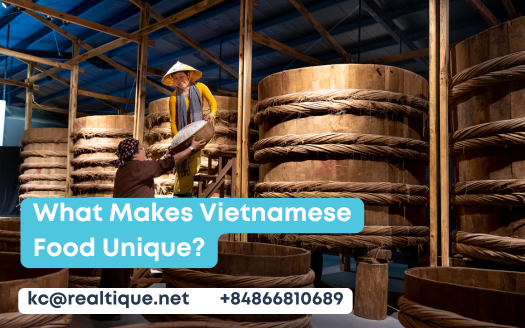What Makes Vietnamese Food Unique?
Ever considered what makes Vietnamese food stand out in the vast culinary world? Its distinctness lies not just in the ingredients used, but also in the careful balance of flavors that tantalize your palate. You’re introduced to a harmony of sweet, sour, bitter, salty, and umami in a single dish, offering a sensory experience unlike any other. But there’s more to it. With influences spanning centuries and various cultures, the cuisine’s evolution is a fascinating tale. So, are you ready to investigate what truly sets Vietnamese food apart?
Table of Contents
The Intricacies of Vietnamese Flavors
Plunge into the world of Vietnamese cuisine and you’ll uncover a staggering variety of flavors. This isn’t your typical fare; it’s a culinary expedition that’s as diverse as the country itself.
From the spicy, complex tastes of the north to the fresh, lively flavors of the south, there’s something to tantalize every palate.
You’ll find a unique balance in Vietnamese food – a harmony of five fundamental taste senses. Each dish incorporates sweet, sour, bitter, salty, and umami, creating an orchestration of flavor that dances on your tongue.
It’s not just about individual components; it’s how they come together to create a captivating culinary experience.
Take the national dish, Pho, for example. It’s a fragrant, comforting bowl of rice noodle soup, but it’s so much more than that. The rich, aromatic broth, the tender slices of meat, the fresh herbs, and the spicy kick of chili – each element complements the other, creating a dish that’s both complex and satisfying.
In Vietnamese cuisine, it’s not just about feeding your body; it’s about nourishing your soul.
And once you’ve tasted it, there’s no going back.
Essential Ingredients in Vietnamese Cuisine
Having savored the intricate dance of flavors in Vietnamese dishes, you might wonder about the key players behind this gastronomic performance. Well, let’s reveal the curtain.
Vietnamese cuisine’s magic largely boils down to a handful of essential ingredients.
First up is fish sauce or ‘nuoc mam’, a salty, pungent liquid extracted from fermented fish. It’s the backbone of Vietnamese cooking, adding depth and umami to dishes.
Then there’s rice in various forms – steamed, noodles, or paper-thin wrappers. It’s the canvas on which the lively flavors are painted.
Fresh herbs like mint, basil, and lemongrass are the soul of Vietnamese food. They lend refreshing, aromatic notes that balance the hearty elements.
Chilies and lime, on the other hand, provide that zingy kick, contrasting with the more subtle flavors.
Now, imagine these ingredients working together, creating harmony in every bite. The fish sauce enhances the taste of the rice, the herbs lighten the dish, and the chilies and lime cut through the richness.
That’s the essence of Vietnamese cuisine. It’s all about the balance and interplay of flavors, thanks to these essential ingredients.
Health Benefits of Vietnamese Food
You might be pleased to know that Vietnamese food doesn’t just taste good, it’s incredibly good for you too.
This cuisine is a goldmine of health benefits. It’s often low in fat and packed with nutrients, leading to a bunch of positives for your overall wellbeing.
The health benefits of Vietnamese food are numerous. It’s always cooked with fresh ingredients, which are less processed and therefore better for you.
Often, it includes a variety of veggies, providing you with a plethora of vitamins and minerals.
Let’s break down some of the key health benefits:
- Low in fat: Vietnamese food often uses lean meats and plenty of fresh fruits and vegetables, keeping the meals low in fat.
- High in nutrients: Thanks to the abundant use of fresh herbs and vegetables, meals are rich in essential vitamins and minerals.
- Controlled portions: Vietnamese meals are usually served in controlled portions, helping to prevent overeating.
- Balanced meals: The cuisine values the balance of flavors and ingredients, ensuring that meals are nutritionally balanced.
Influence of Historical Events on Vietnamese Cuisine
Despite being small in size, Vietnam’s culinary scene has been shaped and influenced by a series of historical events. You can’t ignore the mark left by Chinese occupation for a millennium. It brought to the table, stir-frying and noodle-based dishes, such as phở.
You’ll also find the use of chopsticks a Chinese influence.
The French colonization, too, left a lasting impression. You’ll notice that in the prevalence of baguettes, pâté, and coffee in the local food culture. Vietnamese coffee, or cà phê sữa đá, is a unique combination of French influence and local ingredients.
Vietnam’s historical trade routes also played a part. Spices from India and Thailand found their way into Vietnamese kitchens, adding heat and flavor to the food. You’ll taste chili and coconut milk in the Southern dishes, influenced by the spice trade.
In the past, Vietnam’s food was largely shaped by its need for survival, with dishes made from simple, local ingredients.
But through invasions and trade, it’s been enhanced by various influences, creating a unique, diverse cuisine. It’s history served in a bowl, a reflection of the country’s resilience and adaptability.
Vietnamese Street Food Culture
In the heart of Vietnam’s vibrant cities and charming towns, the street food culture is a colorful demonstration of the country’s rich culinary heritage. You’ll find street vendors at every corner, serving a variety of dishes that are as diverse as they’re delicious.
Whether it’s a lively city like Hanoi or a serene town in the Mekong Delta, the street food scene is a sensory feast that engages all your senses.
Discover the unique elements of Vietnamese street food culture:
Fresh and Healthy: Most dishes are prepared with fresh ingredients, offering a balance of flavors and health benefits.
Affordability: Street food in Vietnam is famously cheap, making it accessible to everyone.
Variety: From Pho and Banh Mi to Bun Cha and Banh Xeo, the variety is endless.
Community and Connection: Street food isn’t just about the food, it’s about the shared experience, the vibrant energy, and the connections formed over a shared meal.





